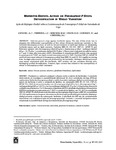Please use this identifier to cite or link to this item:
http://www.alice.cnptia.embrapa.br/alice/handle/doc/963078| Title: | Mefenpyr-diethyl action on fenoxaprop-p-ethyl detoxification in wheat varieties. |
| Authors: | CATANEO, A. C.  FERREIRA, L. C.   MISCHAN, M. M.   VELINI, E. D.   CORNIANI, N.   CERDEIRA, A. L.   |
| Affiliation: | ANA CATARINA CATANEO, IB-UNESP; LEONARDO CESAR FERREIRA, IB-UNESP; MARTHA MARIA MISCHAN, IB-UNESP; EDIVALDO DOMINGUES VELINI, FCA-UNESP; NATALIA CORNIANI, FCA-UNESP; ANTONIO LUIZ CERDEIRA, CNPMA. |
| Date Issued: | 2013 |
| Citation: | Planta Daninha, Viçosa, v. 31, n. 2, p. 387-393, 2013. |
| Description: | Abstract: ABSTRACT - Safeners protect crops against herbicide injury. The aim of this study was to examine the differential susceptibility of five wheat (Triticum aestivum) varieties to the herbicide fenoxaprop-p-ethyl, as well as the performance of mefenpyr-diethyl on minimizing herbicide injury and on lipid contents. Varieties BRS 49, CD 104, CEP 24, IAPAR 78 and Rubi were sprayed with fenoxaprop-p-ethyl (69 g ha 1), fenoxaprop-p-ethyl + mefenpyr-diethyl (69 g + 18.75 g ha-1), or mefenpyr-diethyl (18.75 g ha-1). Plants were evaluated visually for injury at 7 and 14 days after treatment (DAT). Glutathione S-transferase (GST) activity was assayed in aerial parts at 7 DAT, and lipid content was measured at 14 DAT. Varieties CEP 24, IAPAR 78 and Rubi were more tolerant to fenoxaprop-p-ethyl than BRS 49, and CD 104 rapidly recovering from the slight phytotoxicity symptoms produced by the herbicide. Mefenpyr-diethyl prevented crop injury associated with the herbicide. GST activity did not correlate directly with fenoxaprop-p-ethyl detoxification. However, lipid content was related to the susceptibility of wheat to fenoxaprop-p-ethyl treatment. Resumo: Protetores ou safeners protegem culturas contra a injúria de herbicidas. O propósito deste estudo foi investigar a suscetibilidade diferencial de cinco variedades de trigo (Triticum aestivum) ao herbicida fenoxaprop-p-ethyl e o efeito do protetor mefenpyr-diethyl na minimização da injúria do herbicida e sobre o conteúdo de lipídios. As variedades BRS 49, CD 104, CEP 24, IAPAR 78 e Rubi foram pulverizadas com fenoxaprop-p-ethyl (69 g ha-1), fenoxaprop-p-ethyl + mefenpyr-diethyl (69 g + 18,75 g ha 1) ou mefenpyr-diethyl (18,75 g ha 1). A injúria das plantas foi avaliada visualmente aos 7 e 14 dias após o tratamento (DAT). A atividade da glutationa S-transferase (GST) foi analisada na parte aérea aos 7 DAT, e o conteúdo de lipídios, aos 14 DAT. As variedades CEP 24, IAPAR 78 e Rubi foram mais tolerantes ao fenoxaprop-p-ethyl do que a BRS 49, e a variedade CD 104 rapidamente se recuperou dos sintomas de intoxicação produzidos pelo herbicida. Mefenpyrdiethyl preveniu a injúria da cultura pelo herbicida. A atividade da GST não foi correlacionada diretamente com a desintoxicação do fenoxaprop-p-ethyl. Contudo, o conteúdo de lipídios esteve relacionado à suscetibilidade de trigo ao tratamento de fenoxaprop-p-ethyl. |
| Thesagro: | Trigo Herbicida |
| NAL Thesaurus: | Wheat Pesticide selectivity Glutathione transferase Lipid content Herbicide safeners |
| Keywords: | Conteúdo de lipídios Seletividade |
| Type of Material: | Artigo de periódico |
| Access: | openAccess |
| Appears in Collections: | Artigo em periódico indexado (CNPMA)  |
Files in This Item:
| File | Description | Size | Format | |
|---|---|---|---|---|
| 2013AP07.pdf | 554.6 kB | Adobe PDF |  View/Open |









